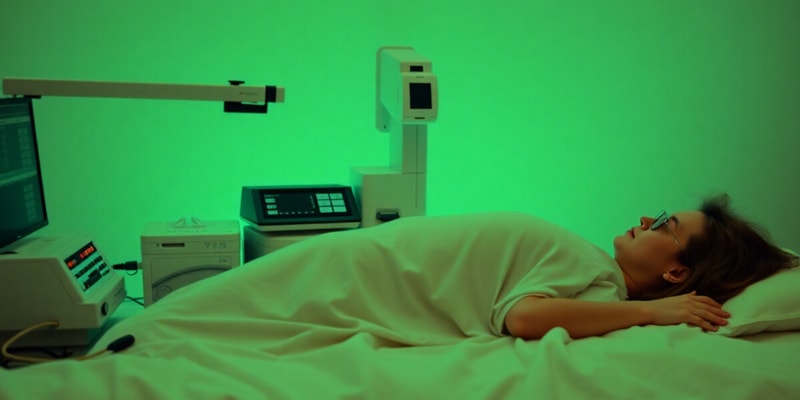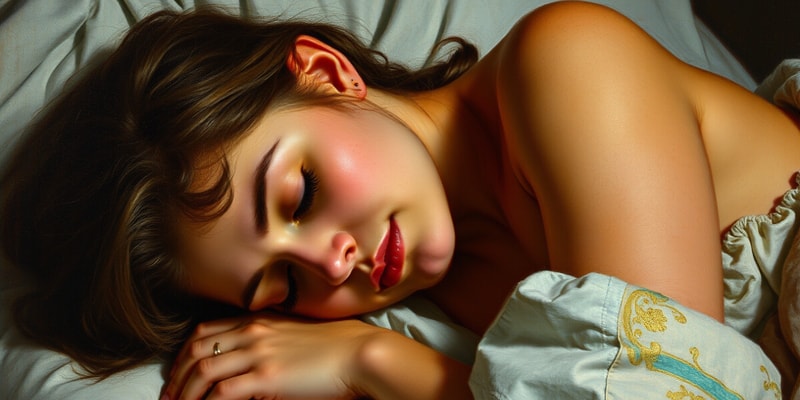Questions and Answers
Which physiological characteristics are recorded simultaneously during a polysomnography study?
What is the primary goal of preparing a patient for a polysomnography study?
Which channels are used to stage sleep in polysomnography?
What should a technician be vigilant about during a polysomnography study?
Signup and view all the answers
What is the purpose of using high-frequency filters in polysomnography?
Signup and view all the answers
During a polysomnography recording, which of the following is NOT typically included?
Signup and view all the answers
What is the role of the control room in a polysomnography lab?
Signup and view all the answers
Which adjustment can help attenuate slower-frequency artifacts like sweat artifact?
Signup and view all the answers
What percentage of patients with Restless Leg Syndrome exhibit Periodic Limb Movements in Sleep (PLMS)?
Signup and view all the answers
Which respiratory monitoring technique is considered the gold standard?
Signup and view all the answers
Which monitoring technique is known for measuring changes in thoracoabdominal cross-sectional areas?
Signup and view all the answers
What type of signal do piezoelectric strain gauges emit in response to changes in length or pressure?
Signup and view all the answers
Which method provides a more sensitive detection for airflow limitation compared to thermal devices?
Signup and view all the answers
What does end-tidal CO2 (ETCO2) monitoring detect?
Signup and view all the answers
What physiological occurrence can respiratory events be associated with in patients with PLMS?
Signup and view all the answers
What is the purpose of the thermistor in oronasal temperature monitoring?
Signup and view all the answers
What should technicians document when there is suspicion of RBD or complex movements suggesting dream enactment?
Signup and view all the answers
Which of the following types of studies cannot perform sleep scoring?
Signup and view all the answers
What is a notable advantage of digital polysomnography over traditional methods?
Signup and view all the answers
What is the minimum requirement for channels in a Type 2 study?
Signup and view all the answers
Which artifact is primarily caused by movements of the head, eyes, and mouth during PSG monitoring?
Signup and view all the answers
What procedural step is involved in ending a PSG study?
Signup and view all the answers
What type of study is defined as involving a single-channel device that records one physiological parameter?
Signup and view all the answers
What physiological artifact is characterized by a time-locked relationship with breathing?
Signup and view all the answers
What is the primary purpose of a 60-Hz notch filter?
Signup and view all the answers
What is the ideal maximum value for the common mode rejection ratio in differential amplifiers?
Signup and view all the answers
Which of the following is NOT a typical application for a direct current amplifier?
Signup and view all the answers
What is the standard recording speed for traditional PSG?
Signup and view all the answers
In EEG recordings, which waves are primarily seen in the occipital leads during wakefulness?
Signup and view all the answers
Which electrode placement is correct for the EOG recording?
Signup and view all the answers
During REM sleep, how is the density of rapid eye movements (REM density) characterized?
Signup and view all the answers
What happens to EMG tone as one progresses from NREM to REM sleep?
Signup and view all the answers
What does capnography primarily measure in the context of sleep-related disorders?
Signup and view all the answers
Which value indicates a potential sleep hypoxemia scenario during a sleep study?
Signup and view all the answers
What is an essential procedure to detect nocturnal GERD?
Signup and view all the answers
What body position is particularly important to monitor in patients with sleep-disordered breathing?
Signup and view all the answers
What is the primary purpose of the microphone during the monitoring of snoring?
Signup and view all the answers
What type of calibration must a technician perform on sleep study equipment?
Signup and view all the answers
What expertise should technicians have regarding unusual behaviors during a sleep study?
Signup and view all the answers
What is NOT typically a result of esophageal pH monitoring conducted during a sleep study?
Signup and view all the answers
Study Notes
Polysomnographic Recording Technique
- Polysomnography (PSG) records multiple physiological characteristics during sleep, including wakefulness, sleep stages, respiration, cardiopulmonary function, and body movements.
- Key recording channels: Electroencephalography (EEG), electro-oculography (EOG), chin muscle electromyography (EMG), airflow, respiratory effort, finger pulse oximetry, and ECG.
- Specific channels included: limb EMG, snore, PES, esophageal pH, penile tumescence, video and audio recording.
Patient Preparation for PSG
- Aim to recreate a typical night’s sleep in a familiar bedroom setting, accommodating the patient's usual sleep schedule.
- Technicians need knowledge of PSG equipment, important sleep disorders, and reasons for the sleep study.
- Use of questionnaires and clinical summaries aids decision-making; vigilance for artifacts is essential.
Laboratory Environment
- Simultaneous video and audio recordings monitor patient behavior during sleep.
- A control room must have remote functions and intercom for communication, documenting abnormal behaviors.
Technical Considerations and Equipment
- Biological signals are amplified and filtered to improve signal clarity; high and low-frequency filters help minimize artifacts.
- EEG monitors at a standard speed of 10 mm/sec, with 60-second epochs used for better visualization of respiratory events.
Electroencephalogram (EEG)
- EEG recordings identify wakefulness and sleep stages; at least three channels are needed, referencing to mastoid electrodes.
- Alpha waves dominate in wakefulness, while major sleep architecture features such as vertex waves and sleep spindles show best in frontal and central leads.
Electro-oculography (EOG)
- EOG is essential for accurate sleep staging; electrodes placed near the eyes detect eye movements.
- Eye movements include vertical blinks and lateral movements, with characteristics of REM sleep involving rapid bursts.
Electromyography (EMG)
- EMG records muscle activity, aiding in the diagnosis of parasomnias; channels include chin and bilateral leg EMG for limb movements.
- Muscle tone decreases through NREM sleep, disappearing during REM; periodic limb movement disorder (PLMD) frequently co-occurs with other sleep disorders.
Electrocardiography (ECG)
- A single channel of ECG detects cardiac rhythm abnormalities, including bradytachyarrhythmias.
Respiratory Monitoring Techniques
- Intraesophageal pressure monitoring is the gold standard but not routine due to discomfort; normal pressure changes are about 5 cm H2O.
- Respiratory inductive plethysmography (RIP) measures thoracoabdominal movements, while piezoelectric strain gauges record respiratory movements via belt sensors.
Measurement of Airflow
- Various techniques include oronasal temperature monitoring (thermistors and thermocouples), nasal pressure monitoring (using pressure-sensitive transducers), and pneumotachography for tidal volume measurement.
- Capnography monitors expired carbon dioxide (ETCO2), indicating OSA and hypoventilation; significant CO2 increases (10 mmHg or more) may signal sleep-related hypoventilation.
Oxygen Saturation and Monitoring Techniques
- Routine noninvasive measurement of oxygen saturation through finger pulse oximetry records arterial oxyhemoglobin levels.
- Significant hypoxemia defined as time spent with SpO2 below 90%, particularly in supine or REM sleep positions.
Esophageal pH Monitoring
- Specialized but not routinely performed; detects nocturnal gastroesophageal reflux disease (GERD), which may mimic sleep apnea.
Snoring Monitoring
- Snoring assessed via microphone, though no standardized grading system exists; technologist notes and physician review provide insights into snoring severity relative to body position.
PSG Calibration
- Equipment calibration involves testing all channels with known signals to ensure accurate settings for frequency filters and sensitivities.
Technician Education and Safety
- Technicians must recognize behaviors indicative of seizures and ensure proper camera focus during unusual behaviors.
- Training includes cardiopulmonary arrest procedures and safety against injury during monitoring.
Ending the Testing
- Lighting conditions and reassessment of equipment are necessary before concluding PSG; patients complete post-study questionnaires.
Portable Monitoring Types
- Type 1 studies are traditional attended PSGs; Type 2 studies require multiple channels for unattended sleep scoring, including airflow and respiratory effort.
- Type 3 studies have fewer channels and cannot allow sleep scoring; Type 4 studies are simple portable oximetry limited to one reading.
Digital Polysomnography
- Facilitates data manipulation and scoring based on patterns; replaces paper PSG with electronic records but may face compatibility issues.
Artifacts During Monitoring
- Physiological artifacts include muscle activity obscuring EEG and movement-induced distortions; sweating can cause slow-frequency waves, while respiratory artifacts are time-locked to breathing.
Studying That Suits You
Use AI to generate personalized quizzes and flashcards to suit your learning preferences.
Related Documents
Description
This quiz covers the essential techniques used in polysomnography, including the various physiological characteristics recorded during sleep, key channels and patient preparation for PSG. It also discusses the importance of a familiar environment and the tools used by technicians to ensure accurate results.




